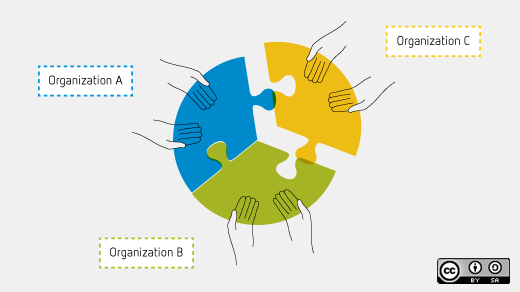Late last year, I was meeting with a business owner to whom I've been a trusted advisor for some time. After conducting discovery interviews with his core team to understand their recruiting and staffing processes, I suggested that this leader leverage his core team for input on how to staff projects. By seeking his senior managers input, I argued, the teams could then position the collaborative efforts to best suit the company and client needs. Input from those involved would allow for engagement planning that relied on the top skill sets of all available staff, and it would align well with staff bandwidth to optimize the project results.
The response I received stunned me. "This is not a democracy," the leader said.
Open organizations' governance models will vary. But leaders in those organizations need to define them. Let me explain how to do that.
Your ecosystem's framework
Governance is the processes of interaction and decision-making among the actors involved in a collective problem that lead to the creation, reinforcement, or reproduction of social norms and institutions. Simply put, it's the framework that creates the structure of the organizational system and the rules by which the parts of that structure can and do interact with one another.
An important step in the transition to an open organization will be defining the framework within which organization's various ecosystems will operate. Much like natural ecosystems, organizations require a framework to exist and function. They need balance, rules of order, movement, and an interdependency between all players in the system.
There are two distinct reasons our example company has experienced a sharp decrease in business, high turnover, loss of trusted talent, and a diminished work product for clients that we can learn from today.
First, our example model operates as an autocracy, a closed model, as a form of governance. Closed models are no longer sustainable for 21st Century businesses, as demands from both consumer and employees desire open mindsets.
Second, the company didn't have a consistent framework for its governance—it varied when the mood changed. A business cannot grow, thrive, or sustain itself on whims; it needs defined and reliable mechanisms.
The costs of turnover, diminished client base, and, ultimately, declining reputation are too high of a price to pay to staying loyal to outdated thinking or pride.
Thinking about open governance
One way to think about governance is to view it as standard operating procedures—the rules of the road, if you will. Without them, you invite chaos that impacts all aspects of your business.
The transition from traditional leadership and organizational structures to open models can be challenging for most. Openness often seems counterintuitive and contrary to everything you have learned or have experienced. Yet those who hold fast to ways that no longer work can bring swift destruction to their clients, teams, and bottom lines.
In his book The Open Organization, Dr. Philip Foster defines governance as "the system and process by which power is managed and thus instills order where potential conflict threatens the opportunities to realize mutual gains which is essential for open organizations." According to Dr. Foster, open governance models for 21st Century businesses should contain five core elements: independence, pluralism, representation, decentralized decision making, and autonomous participation.
Independence
As a governance mechanism, independence requires that decision making at the lowest levels is unencumbered from any single external controlling influence.
Pluralism
Pluralism is the mechanism that helps the organization be more competitive in a globalized economy. Individuals from different backgrounds are together in a social context but continue to have their different traditions and interests.
Representation
Inclusion is a significant pillar for open models. Thus, a defined framework through which all members of the organization are represented is vital.
Decentralized decision making
Your defined framework must embrace and outline specific rules of engagement for decision making. Empowering and trusting your people to do the right thing is a significant part of open leadership.
Autonomous participation
This defines the level of autonomy available to the members of the organization. Thus providing parameters to allow their input on everything from which projects they would like to work on outside of assigned responsibilities to their career pathways to providing ideas to solutions.
One of the beautiful things about open thinking is that it makes room for so many variations. But to get to a working, healthy organization, open leaders need to define frameworks and set foundations for participation.
Participative organizations flourish and excel. Let go of your fear of transitioning to open models, leverage open resources, and partner with those who can help manage the change.






4 Comments